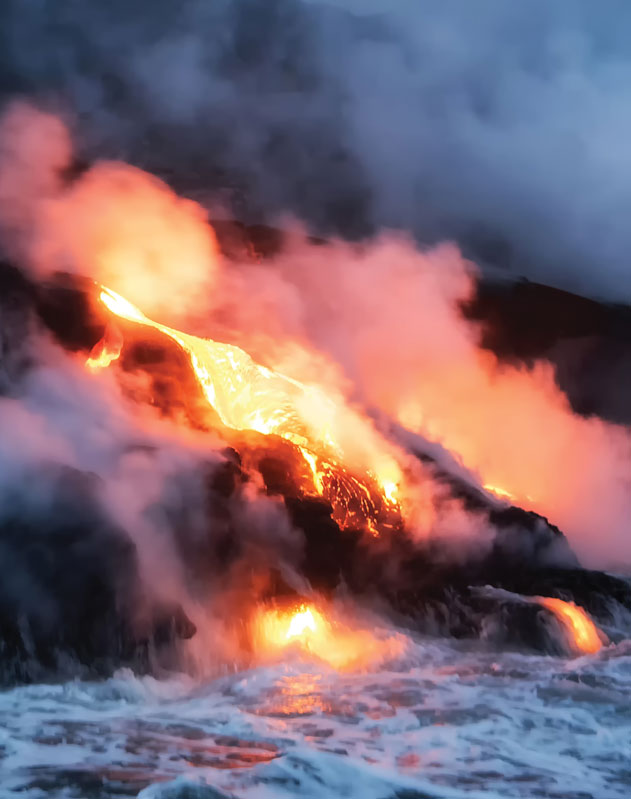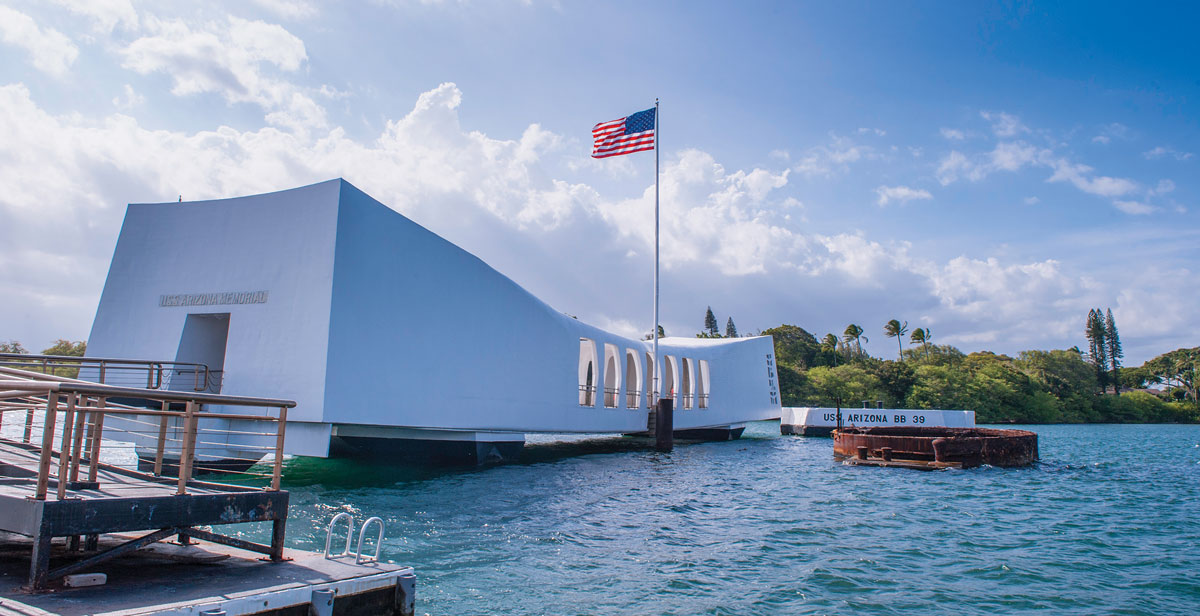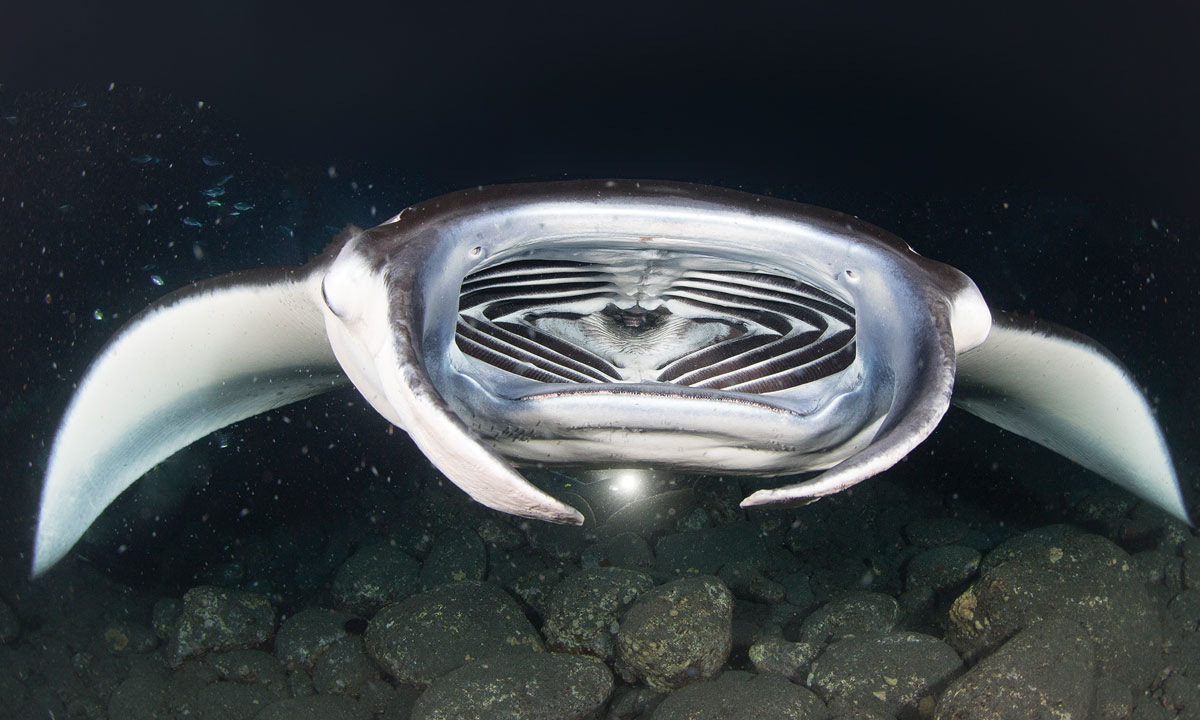HAWAII IS A PLACE WE’VE VISITED MANY TIMES. Except that it’s more than just one place. Hawaii, the United States’ 50th state is a string of islands, atolls, small islets and seamounts forming an archipelago that spans 1,500 miles (2,400 km) of central Pacific Ocean. Over 130 points of land make up the northernmost Polynesian Island Group. Hawaii’s eight main islands, from northwest to southeast are: Niihau, Kauai, Oahu, Molokai, Lanai, Kahoolawe, Maui and the Island of Hawaii — which is the largest of them all. It is often called the “Big Island.”
On our most recent Hawaii trip last April, we visited the Big Island. During our stay, heavy rains caused flash flooding on the north shore of Kauai. Friends who knew we were “in Hawaii” texted, concerned for our safety. They were pleased to learn we were on a completely different island a few hundred miles away, enjoying sunny weather and perfect diving conditions.
In May, when Mount Kilauea erupted on the Big Island’s east side, it had no impact on the popular Kona tourist area located on the west coast. Our favorite resort and Kona dive center were — and still are — open for business as usual.
We love Hawaii and have visited most of its islands. Our hearts go out to those in the Puna District on the Big Island who have lost their homes to the lava flow. We’d like to devote part of this article to providing a sense of place for those who’d like to visit the islands of Hawaii sometime soon.

Lava from the Big Island’s Mt. Kilauea reaches the sea.
Go or No-Go?
The recent lava flows from Mount Kilauea have received dramatic media coverage. It would be easy to get the mistaken impression that the Big Island is one big molten fireball. What you might not know is that Kilauea has been erupting on a continuous basis since 1983. In the last 35 years, countless vacationers have visited the Big Island — and Hawaii’s other islands — without being at risk from volcanoes.
RELATED READ: ‘MUSIC IN THE AIR’: THE SWEET MELODIES OF HAWAII’S BIG ISLAND
Currently, most of Hawaii Volcanoes National Park remains closed but all of the Big Island’s popular tourist attractions are reported to be unaffected.
Earlier we pointed out that the Hawaiian Islands cover a 1,500-mile (2414 km) area. To put this in perspective consider the distance from Chicago to Key Largo is 1,440 miles (2,317 km). Blustery weather in the Windy City is not likely to affect your trip to the Keys.
Still, potential travel problems like volcanoes and tropical storms and civil unrest are real threats, so it pays to educate yourself about a destination and make informed decisions. Before you plan any type of travel, we suggest you follow these tips: ask your travel specialist about potential risks; search official websites for advisories and purchase trip cancellation insurance. Once you’ve done what you can to learn about and mitigate potential travel risks, go have fun.

The USS Arizona rests at the bottom of Oahu’s Pearl Harbor. The site is a memorial to U.S. soldiers who died when Japanese bombers attacked.
A Hawaiian Islands History Primer
The Hawaiian Islands’ origin stories vary. Research indicates the islands were first settled 1,000 years B.C. or more when Polynesians from the Marquesas and Tahiti thousands of miles to the south reached the Big Island in massive sailing canoes. Local folklore suggests a mythical race of tiny people called Menehune — the Polynesian equivalent of a leprechaun — were the first people. Incidentally, the Menehune population is rumored to be alive and well in the islands. Although no one ever sees the Menehune, they are often blamed for small acts of mayhem and mischief, like hiding people’s car keys.
Early Hawaiians were skilled sailors, fishermen and farmers. They were closely tied to nature and worshipped many gods, who took both human and animal form.
The first European to visit was Captain James Cook who landed on Kauai in 1778. Cook originally named the islands the Sandwich Islands after a British earl. He was killed a year later in a dispute with locals on the Big Island. During that time there were many power struggles, with several chiefs vying for control of the islands. Between 1791 and 1810 King Kamehameha unified the islands under his rule. He died in 1819. Hawaii’s first king is still celebrated every June 11, which is King Kamehameha Day.
Christian missionaries arrived in 1820. Then came an influx of Western traders and whalers. With them came diseases that devastated the local population, reducing their numbers from over 300,000 when Cook first arrived, to about 70,000 by 1853.
American colonists soon dominated Hawaii’s flourishing sugar industry. In the late 1890s the last Hawaiian monarch, Queen Liliuokalani was deposed and the Republic of Hawaii was established. The United States annexed Hawaii as a territory in 1898.
On December 7, 1941, Oahu’s Pearl Harbor became infamous as the site where Japanese bombers killed over 2,300 Americans, forcing the U.S. to enter World War II. The USS Arizona sank with 1,100 men aboard. The site is now venerated as a memorial to those who died in the attack.
Hawaii gained statehood on August 21, 1959, which means passports are not needed for US citizens traveling to Hawaii. Tourism and agriculture are among the major industries in Hawaii.

Sea turtles serve as unofficial “greeters” on Hawaiian dive sites. MARTY SNYDERMAN PHOTO.
Truly Rare Tropical Paradise
Hawaiian wildlife spent 70 million years evolving in isolation. As a result, many of its native plants and animals are found nowhere else on earth. Introduced species like pigs, rats and domestic cats have wreaked havoc, reducing many native populations of tropical birds, plant life and animals. In fact, Hawaii is often referred to as “The Endangered Species Capitol of the World” because so many endemic species are now listed as endangered or threatened. As part of their ongoing native ecosystems management program, the state’s Division of Forestry and Wildlife promotes a Rare Plant Code of Conduct, available at dlnr.hawaii.gov/ecosystems/rare-plants/.
RELATED READ: HOW SCIENTISTS IDENTIFY NEW SPECIES

The Papahānaumokuākea Marine National Monument is a World Heritage listed U.S. National Monument encompassing 583,000 square miles (1,510,000 km2) of ocean waters, including 10 islands and atolls northwest of Hawaii’s main islands. It was first created in 2006 and then expanded in 2016. It is now one of the world’s largest protected areas and is slightly larger than Australia’s Great Barrier Reef Marine Park.
Diving the 5-0
No matter which island you visit for diving, you’re in for a real treat. The underwater visibility is excellent — water temperatures range from 77 to 82 degrees Fahrenheit (25 to 27.8 Celsius). A full 3-mm or 5-mm wet suit is recommended. Average dive depths are suitable for divers of all experience levels, although there are also sites best explored by those with advanced diving skills.
And just like its terrestrial species, many underwater species found on Hawaii’s reefs are endemic — more than 1,250 unique species of marine life are found here. You won’t find soft corals here but you’ll likely share your dives with several green sea turtles and squadrons of eagle rays. In many areas, ancient lava flows have left unusual underwater features including tubes, tunnels and small caverns perfect for divers to explore. Underwater photographers will love the ruggedness of the topography. Schools of endemic milletseed butterflyfish flutter around like yellow clouds. Whitetip reef sharks and grey reef sharks are commonly sighted. During winter months it’s not uncommon for divers to hear humpback whale songs while submerged.
Some islands have sites accessible from shore but boat diving is the norm on most islands. Because Hawaii is a state, dive charter boats must adhere to regulations set forth by the U.S. Coast Guard, including having emergency first aid and oxygen onboard. Nitrox is readily available.
In terms of the diving, Hawaii offers a menu that includes reefs, walls, pinnacles and seamounts, several wrecks and some amazing mission-specific animal encounters. It’s safe to say each island has its signature feature. On the Big Island, Kona’s manta ray night dive (or snorkel) is a must-do. Our recent manta night dive put us close to 15 gigantic mantas, all swirling about feeding on a soup of small plankton. While waiting for the sun to set we also saw a massive Hawaiian monk seal, which is the only seal native to Hawaii. It’s listed as an endangered species, which made the sighting extra special.

A manta ray night dive off the Big Islands’ Kona coast is a must-do. MARTY SNYDERMAN PHOTO.
Oahu has several superb shipwrecks. The YO-257, a 175-foot (53-m) Navy yard oiler built in the 1940s was sunk as an artificial reef off Waikiki in 1989. The “YO” rests on the sand in 95 feet (29 m) of water. Just a short swim away is the San Pedro. The Atlantis Submarine Company sunk both boats as attractions for their sub guests. The 168-foot (51-m) Sea Tiger is off Oahu’s south shore. Dive depths range from about 80 to 100 feet (24 to 30 m).
RELATED READ: THE BEST WRECKS IN AMERICA’S NATIONAL MARINE SANCTUARIES
Kauai’s more protected south shore features sites with dramatic volcanic features. You’ll get your fill of green sea turtles here. The north and east sites are also exceptional but are only accessible in calm weather. The island of Niihau, 17 miles (27.4 m) to the west of Kauai, is a private island off-limits to tourists but dive charters are available for experienced divers. The dive sites, although deep, are pristine.
Maui is especially popular with divers because it has scores of interesting sites all around the island, including the nearby island of Lanai, with its stunning cathedrals. Molokini crater off Maui is also very popular with divers. The backside of Molokini features a deep wall. It’s a perfect dive for pelagic encounters.
The “black water” night dive is trending in Hawaii, as it is in other diving destinations worldwide. On a black water dive, charter boats take divers offshore into “bottomless” depths; the dive is centered on a line suspended from the boat outfitted with lights that attract plankton and all sorts of larval marine life. The dive is planned at shallow depths but, because you’ll be offshore in extremely deep water at night, this type of dive is best suited for those with prior advanced/night diving experience and expert buoyancy control.
Shark diving and snorkeling is also popular and is conducted with and without cages. Ask your local dive operator for details and plan to book early for this or any other “specialty” dive.

It’s always a pleasure to see a spinner dolphin living up to its name. MARTY SNYDERMAN PHOTO.
Living Aloha
No matter which Hawaiian Island you visit, you’ll find yourself in the land of aloha. In the Hawaiian language, the word has many meanings. It can mean hello or goodbye and it also means love and affection. Another important Hawaiian word is mahalo, which means thank you.
Every island has a full complement of cultural offerings, including traditional luaus, hula lessons and activities such as lei making and Hawaiian cooking classes. Nature tours and hikes are among the hallmarks of Hawaiian adventures, as are a variety of water sports including surfing, sailing and fishing. There’s golf, too. The islands are home to several prestigious championship courses. When you’re not diving, there’s plenty of topside adventure to enjoy. Or plenty of beautiful beaches on which to relax.
When it comes to accommodations and restaurant choices, the options are just as plentiful. Hotels and condos range from budget to big-dollar options. Private home and villa rentals are also a nice option, particularly for multi-generation family vacations. Hawaiian- and Asian-inspired cuisine rules here but you’ll find dining options from high-end restaurants to local hotdog stands and roadside food trucks serving up some of the best barbecued ribs and Kahlua pork you’ll ever taste.
There’s a reason we keep returning to Hawaii. Many reasons, actually. If we had to list them, we’d rank the aloha spirit of the people, the incredible scuba diving options and the islands’ breathtaking natural beauty at the top of our list. No matter which of its islands you visit, there’s no place like the Hawaiian Islands.
By Cathryn Castle Garcia and Gui Garcia





